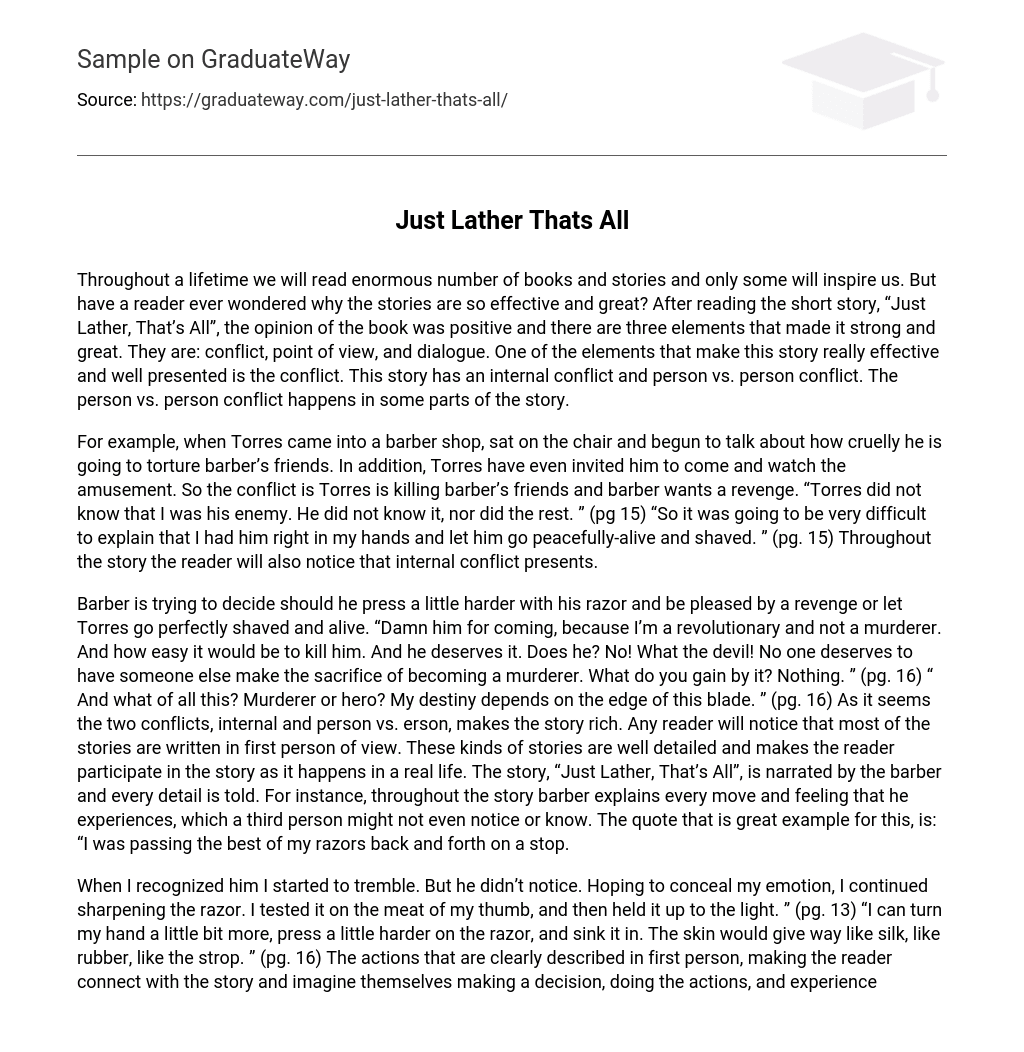In our lives, we come across numerous books and tales that have the power to inspire us. However, have you ever pondered over what sets these stories apart? Upon reading the short story “Just Lather, That’s All,” I was truly amazed by its brilliance. Three crucial factors contribute to its strength and greatness: conflict, point of view, and dialogue. The inclusion of both internal conflict and person vs. person conflict is one particular element that enhances the effectiveness of the story. This conflict arises at various points in the narrative.
For instance, when Torres entered a barber shop and took a seat, he immediately started discussing his plans to cruelly torture the barber’s friends. Furthermore, Torres even extended an invitation for the barber to witness the twisted spectacle. Thus, the conflict arises from Torres’ actions of killing the barber’s friends, prompting the barber to seek revenge. “Torres was unaware that I was his adversary. He, along with everyone else, remained unaware.” (pg 15) “Consequently, it would prove exceedingly challenging to explain how I had him within my grasp and chose to let him go unharmed and cleanly shaven.” (pg. 15) Throughout the story, the reader will also observe the presence of internal conflict.
The barber is faced with a dilemma – should he kill Torres and seek revenge or spare him? Despite his anger towards Torres and belief that he deserves to die, the barber realizes that no one deserves to be turned into a murderer. He contemplates the consequences of taking a life and recognizes that it would bring him nothing. The decision between becoming a murderer or a hero will determine his future. This internal conflict within the barber, along with the external conflict between himself and Torres, adds depth to the story. Narrated in first person, the narrative provides an intricate account of the barber’s thoughts and actions that may not have been noticed by someone outside the situation. In “Just Lather, That’s All,” the barber describes each movement and emotion he experiences while hesitating over whether to pass his razor back and forth on a stop.
When I first saw him, my body immediately started shaking uncontrollably. However, he remained completely unaware of my condition. To conceal my intense emotions, I continued sharpening the razor that I had in my possession. As a test, I lightly ran it across my thumb and held it up to the light. Many thoughts flooded my mind: “If I adjust my hand slightly and apply more pressure, this blade could effortlessly penetrate. The texture of the skin would yield smoothly like silk or rubber or the strop.” These detailed descriptions of actions are narrated from a first-person perspective, allowing readers to connect with the story’s atmosphere and immerse themselves in decision-making, tasks performance, and concealed emotions.
Dialogue is essential in making a book or short story captivating and intriguing. It breathes life into the narrative, enabling readers to form connections with the characters and acquire a deeper understanding of their personalities. In “Just Lather, That’s All,” dialogue serves as an effective tool through the narration of a familiar barber. Yet, Torres, the second character in the tale, remains mysterious. Consequently, the conversations between these two individuals not only forge a bond but also introduce other characters while gradually unveiling specific information about them.
The story demonstrates a mutual dislike between the barber and Torres, although it remains uncertain how Torres feels about the barber. This ambiguity is evident in Torres’ final statement: “They told me that you’d kill me. I came to find out. But killing isn’t easy. You can take my word for it.” (pg. 17) This conversation implies that Torres was aware of the barber’s animosity towards him and intentionally sought him out to determine whether the barber would choose to spare or kill him.
In addition, the barber’s patience was tested and his anger provoked by Torres during their interaction. As stated on page 13, Torres confidently states, “But we did all right, you know. We got the main ones. We brought back some dead, and we’ve got some others still alive. But pretty soon they’ll all be dead.”
By including dialogue in a narrative, it brings life to the story and sparks curiosity among readers. Ultimately, the success of a story lies in its ability to captivate its audience. This particular tale stands out because it effectively incorporates three essential elements: conflict, point of view, and dialogue.
The use of two conflicts, namely internal and person vs. person, enhances the story “Just Lather, That’s All.” By employing a first-person point of view from the barber’s perspective, the story becomes more intriguing as it pays attention to detail. Moreover, through dialogue, readers gain insights into other characters and breathe life into the narrative. In my view, this story serves as an exceptional example for students by demonstrating how various elements can captivate readers and keep them engaged throughout.





